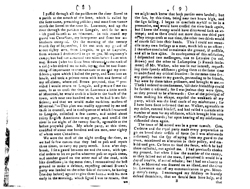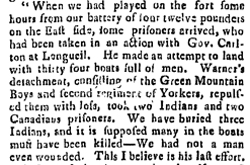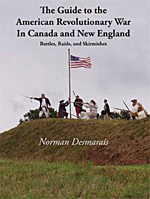I used to think I knew quite a bit about the American Revolution—until I became a re-enactor. I certainly knew that the war consisted of more than the battles of Lexington and Concord, Bunker Hill, Trenton and Princeton, Saratoga, Camden, Guilford Courthouse, and Yorktown. I soon learned that even the most detailed history books don’t cover all the military engagements.
When I participated in the 225th anniversary re-enactments, I overheard fellow interpreters commenting about some of these events they knew nothing about. There had been no guidebooks published about the Revolutionary War since the nation’s bicentennial in 1975. Moreover, those guidebooks only covered the major, better known events. This compelled me to begin work on what I intended as a comprehensive, if not exhaustive, military history of the American War for Independence.
The Guide to the American Revolutionary War in Canada and New England: Battles, Raids, and Skirmishes is the first volume of that work. It covers 403 engagements. One of the sources I used for my research was Francis B. Heitman’s Historical Register of Officers of the Continental Army during the War of the Revolution, April 1775 to December 1783 1 which includes an appendix with an alphabetical list of 420 engagements. This list seems to have been adopted as the U.S. Army’s official list of battles and actions. Howard Henry Peckham’s The Toll of Independence: Engagements & Battle Casualties of the American Revolution 2 is the most extensive published list. It expands the total to 1,330 military and 220 naval engagements. However, neither list provides bibliographic references for these encounters. Nonetheless, Peckham’s work has a general bibliography which served as a good starting point for my research.
In the course of that research, I have compiled more than 3,000 events—more than double Peckham’s total—and documented them in the footnotes. The Archive of Americana, which includes Early American Imprints and Early American Newspapers, served as a valuable tool for this research. Journals, diaries, and memoirs of soldiers and participants are important primary sources for this research. However, very few of these sources were published before the end of the eighteenth century and consequently post-date Early American Imprints, which contains only about a dozen 3 of these sources. Only one of the titles includes the keywords “diary,” “journal” or “memoir,” so researchers need to know the authors or titles to locate them. Moreover, they cannot be retrieved by searching on the diary genre for the American Revolutionary War era.
Most of the diaries were published in the nineteenth century—many around the 50th and centennial anniversaries of the war. Some veterans were probably inspired by the commemorations or by questions from their grandchildren asking, “What did you do in the war, grandpa?” Many of these sources still remain unpublished, housed in archives around the country and the world.
Often, my only clue to an event was a date or a date with a brief hint at what happened, such as Captain Ayscough seized a vessel. Sometimes there might be mention of a general location such as the Elizabeth Islands or off Cape Cod. Early American Newspapers was a very valuable source to pursue such vague clues. Not only did I get details about the encounter, I learned that the vessel was a whaling brig and that the action occurred in Tarpaulin Cove at Naushon Island.
Several documentary histories such as those by Gibbes, Jones, Moore, and Stryker 4 are based primarily on excerpts from newspapers. The originals or facsimiles have been almost impossible to locate and these titles have acquired the aura of primary sources. The advent of Readex’s online edition of Early American Newspapers opens new avenues to research and dramatically reduces the time to do that research. Now, scholars not only can locate the original articles in context, they can also study how an article might have changed as it was reprinted in another newspaper.
There’s also a certain serendipity to research. While trying to document an event, I often turned up totally unrelated, but relevant, stories. For example, while researching Colonel Johann Christian DuPuy’s attack on an outpost at New Bridge, New Jersey on April 16, 1780, I discovered that Lieutenant Colonel Aaron Burr and a party of 24 men, with fixed bayonets, rushed on an enemy picket guard of 23 on September 11, 1777. They killed 13, wounded and captured five with two other prisoners. The other three escaped to their camp.5

Universal Advertiser, Oct. 2, 1777
In many cases, newspapers give us the only available information for an event. For example, there were as many engagements in Canada as in Connecticut, and more than in Maine, New Hampshire and Vermont combined. Yet, several are only documented in newspaper accounts. We know, from Lieutenant Colonel Ethan Allen’s Narrative, that as Brigadier General Richard Montgomery was preparing to capture Montréal at the end of September 1775, Allen and his men collected a few canoes at Longueil and spent most of the night of the 24th crossing the St. Lawrence River. Because he had so few canoes, Allen had to pass and re-pass three times to get all his men across. Shortly after crossing, a band of 500 Regulars and militiamen sent out by General Sir Guy Carleton attacked Allen’s force at Montréal. They wounded seven and captured Allen and 45 of his men. Most of the Canadians, about 55, deserted. The Regulars lost three killed and two wounded.6

A November 3, 1775 letter from General Montgomery in The Connecticut Journal 7 tells us that General Carleton tried to land at Longueuil with 34 boats full of Canadians and Native Americans a week later, on Monday, October 30, 1775. Lieutenant Colonel Seth Warner’s Green Mountain Boys and the 2nd Regiment of Yorkers repulsed them, inflicting heavy casualties, burning three Native Americans, and taking two others and two Canadians prisoners—all without having a man wounded.

Eight months later, after suffering defeat at Trois Rivières, the Northern Army had safely retreated to Ile aux Noix with all their artillery, baggage, and supplies. A party of 12 of them went to the western shore of the lake, about a mile from the camp, to fish on Monday, June 24, 1776. Some Native Americans observed them and surrounded them while they were at a house drinking spruce beer. They killed four of the soldiers and captured seven. When a party came from the camp to their relief, two of the prisoners escaped. The others were brought to the Regulars at Montréal. The Native Americans scalped about six other soldiers about six miles north of the island.8

The Archive of Americana is very useful for researching engagements in the colonies also, not only in Canada. While other sources summarize the actions, newspapers give us more specific details. For example, after the Battle of Bunker Hill, British Regulars occupied the hill. Rebel sentries at the foot of the hill reported that the Redcoats had cut down several large trees to construct an abatis to protect a bomb battery they erected during the night. General George Washington ordered Captain Michael Dowdle (or Doudel) and his York County (Pennsylvania) riflemen to march down to the advanced post in an attempt to surround the enemy’s advanced guard and capture prisoners who might explain why they built an abatis on the Neck.
Captain Dowdle took 39 men and filed off to the right of Bunker Hill on Friday evening, July 28, 1775. Creeping on their hands and knees, they managed to get behind the sentinels without being discovered. Meanwhile, Lieutenant John Miller 3rd took another division of 40 men behind the sentries on the left. They were only a few yards away from joining the division on the right when some Regulars came down the hill to relieve their guard early Saturday morning. They were within 20 yards of Captain Dowdle’s riflemen when they spotted the men lying on the ground in an Indian file. The Regulars fired immediately. The riflemen returned fire, killing five soldiers. They also captured two prisoners with their weapons. The same day, the British advanced over Boston Neck and erected a small earthwork to cover their guard.
The following morning, at 1 AM, they retaliated for Captain Dowdle’s attack with a heavy firing of small arms and cannon. The firing continued for several hours and concentrated on three locations: Roxbury, Sewell’s Point at the mouth of the Cambridge River, and the advanced post on Charlestown Neck. They sent two flat bottomed boats to Sewell’s Point to attack the redoubt there; but the boats retired after several hours of useless fire. The British picket guard on Charlestown Neck attacked the Rebel advanced guard, forcing them to retreat. Reinforced by order of Major General Charles Lee, the advanced guard recovered their ground and beat off the Regulars. They killed several and captured seven muskets, without losing a man, even though the engagement occurred within point blank range of British lines.9
Later, a force of 250 Marblehead sailors formed on Plowed Hill (near Bunker Hill) on Monday morning, July 31, 1775 and began firing on the Regulars, driving in all their out guards. The Regulars responded with a cannonade from their earthworks on Bunker Hill. The Marbleheaders captured two marines and killed several Regulars. They only lost one man killed with a cannonball.10
These are just a few of the many instances where newspapers provide the only known sources to information about military engagements during the American War for Independence. Early American Newspapers often allows scholars to find details when they only have general information. It also opens new research opportunities that are impossible with the print editions of newspapers. Researchers accustomed to working with the paper or microfilm editions will still find items they overlooked and their research time will be cut dramatically. Moreover, the Archive of Americana fosters new interpretations of life and events in the 18th century and opens new horizons for interdisciplinary scholarship.
Footnotes
1 Heitman, Francis B. Historical Register of Officers of the Continental Army during the War of the Revolution, April 1775 to December 1783. Washington, DC. : The Rare Book Shop Publishing Company, 1914; Baltimore: Genealogical Publishing Company, 1967.
2 Peckham, Howard Henry. The Toll of Independence: Engagements & Battle Casualties of the American Revolution. Chicago: University of Chicago Press, 1974.
3 Allen, Ethan. A narrative of Colonel Ethan Allen's captivity, from the time of his being taken by the British, near Montreal, on the 25th day of September, 1775, to the time of his exchange on the sixth day of May, 1778, containing his voyages and travels, with the most remarkable occurrences respecting himself, and many other continental prisoners of different ranks and characters, which fell under his observation in the course of the same; particularly the destruction of the prisoners at New York, by General Sir William Howe, in the years 1776 and 1777, interspersed with some political observations. Written by himself, and now published for the information of the curious in all nations. [Two lines from Freneau]. Philadelphia: Printed for and sold by William Mentz, in Cherry Alley., 1779. Early American Imprints, Series 1, no. 16182.
Blatchford, John. Narrative of remarkable occurrences, in the life of John Blatchford, of Cape-Ann, Commonwealth of Massachusetts. Containing, his treatment in Nova-Scotia-- the West-Indies-- Great-Britain-- France, and the East-Indies, as a prisoner in the late war. Taken from his own mouth. New London [Conn.]: Printed by T. Green. M,DCC,LXXX,VIII. (With the privilege of copy-right.), [1788]. Early American Imprints, Series 1, no. 20972. Brissot de Warville, Jaques Pierre. [Examen critique des Voyages dans l'Amérique septentrionale. English]. A critical examination of the Marquis de Chatellux's [i.e., Chastellux's] Travels, in North America, in a letter addressed to the Marquis; principally intended as a refutation of his opinions concerning the Quakers, the Negroes, the people, and mankind. Translated from the French of J.P. Brissot de Warville, with additions and corrections of the author. [One line of quotation in French]. Philadelphia: James, 1788. Early American Imprints, Series 1, no. 20981.
Dodge, John. An entertaining narrative of the cruel and barbarous treatment and extreme sufferings of Mr. John Dodge during his captivity among the British, at Detroit: In which is also contained, a particular detail of the sufferings of a Virginian, who died in their hands. Written by himself; and now published to satisfy the curiosity of every one throughout the United States. second edition. Danvers [Mass.]: Printed and sold by E. Russell, next the Bell-Tavern. M,DCC,LXXX [1780]. Early American Imprints, Series 1, no. 16765.
Morgan, John. A vindication of his public character in the station of director-general of the military hospitals, and physician in chief to the American Army; anno, 1776. By John Morgan, M.D. F.R.S. Professor of the theory and practice of physick in the College of Philadelphia; member of several royal colleges and academies, and philosophical and literary societies, in Europe an America. Boston: Printed by Powars and Willis., M,DCC,LXXVII. [1777]. Early American Imprints, Series 1, no. 15446, 15447.
Narrative of a late expedition against the Indians; with an account of the barbarous execution of Col. Crawford; and the wonderful escape of Dr. Knight & John Slover from captivity in 1782. To which is added, a narrative of the captivity & escape of Mrs. Frances Scott, an inhabitant of Washington County, Virginia. Andover [Mass.]: Printed by Ames & Parker., [1798?] Early American Imprints, Series 1, no. 48378, no. 35689.
Pemberton, Thomas. An historical journal of the American war. Extracted from the publications of the Massachusetts Historical Society. [Boston] : Printed at the Apollo Press, in Boston, by Joseph Belknap, no. 8, Dock Square, MDCCXCV. [1795] Early American Imprints, Series 1, no. 29283, 46845.
Robin, Abbe. New travels through North-America: in a series of letters; exhibiting, the history of the victorious campaign of the allied armies, under His Excellency General Washington, and the Count de Rochambeau, in the year 1781. Interspersed with political, and philosophical observations, upon the genius, temper, and customs of the Americans; also narrations of the capture of General Burgoyne, and Lord Cornwallis, with their armies; and a variety of interesting particulars, which occurred, in the course, of the war in America. Translated from the original of the Abbé Robin, one of the chaplains to the French army in America. [Six lines from Young]. Philadelphia: Printed and sold by Robert Bell, in Third-Street., M,DCC,LXXXIII [1783]. Early American Imprints, Series 1, no. 18167, Boston: Printed by E.E. Powars and N. Willis, for E. Battelle, and to be sold by him, at his book-store, State-Street., M,DCC,LXXXIV. [1784]. Early American Imprints, Series 1, no. 18765.
4 Gibbes, Robert Wilson. Documentary History of the American Revolution. New York : D. Appleton & Co., 1855 (3 vols: 1764-1776, 1776-1782, 1781-1782). reprinted New York Times & Arno Press, 1971. Jones, Thomas. History of New York during the Revolutionary War. (Eyewitness accounts of the American Revolution). New York]: New York Times [1968]. Moore, Frank. Diary of the American Revolution: from Newspapers and Original Documents. New York: Charles Scribner; London: Sampson Low, Son & Co., 1890. Documents Relating to the Revolutionary History, State Of New Jersey. Edited by William S. Stryker. Trenton: The John L. Murphy Publishing Co., 1901.
5The Independent Chronicle and the Universal Advertiser.10:476 October 2, 1777 p. 3 Boston Gazette. 1205 October 6, 1777 p. 2.
6 Allen, Ethan. A narrative of Colonel Ethan Allen's captivity, from the time of his being taken by the British, near Montreal, on the 25th day of September, 1775, to the time of his exchange on the sixth day of May, 1778, containing his voyages and travels, with the most remarkable occurrences respecting himself, and many other continental prisoners of different ranks and characters, which fell under his observation in the course of the same; particularly the destruction of the prisoners at New York, by General Sir William Howe, in the years 1776 and 1777, interspersed with some political observations. Written by himself, and now published for the information of the curious in all nations. [Two lines from Freneau]. Philadelphia: Printed for and sold by William Mentz, in Cherry Alley., 1779. Early American Imprints, Series 1, no. 16182. pp. 8-9
7 Extract of a letter from General Montgomery, dated Camp near St, Johns November 3, 1775. The Connecticut Journal. 424 (November 29, 1775) p. 1 also published in Early American Imprints, Series 1, no. 14541.
8The New England Chronicle. II: 411 (July 4, 1776), p 2 Essex Journal. 3:131 (July 5, 1776). p.3
9The Constitutional Gazette. 4 (Aug. 9, 1775), p. 1.
10 ibid.





